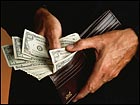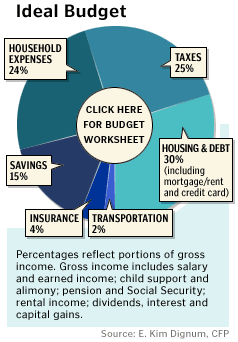
NEW YORK (CNN/Money) - No matter what you make, there is a way to live within your means, stay out of debt and save enough for your short- and long-term goals. It involves a dirty word and pieces of pie.
The dirty word is "budget." Whether you're a spender or saver, there comes a time when you have to get a handle on your cash flow. Maybe you're buying a home, getting married, starting a family or planning for retirement. Or maybe you've just got a credit card balance that makes loan sharks blush.
The pieces of pie are the portions of your income dedicated to broad-based expenses and goals, such as savings, debt and taxes. The size of these pieces can make the difference between living securely and living beyond your means.
Two of the biggest budget blunders people make is not knowing how they spend their money and not prioritizing their financial goals or, at least, not spending money in a way that reflects those priorities.
Of course, there's no down-to-the-penny budget that works for everybody since people differ in their needs and desires. But here is a budget -- with a calculator -- that can serve as a guide to help adjust your spending so you can meet your financial goals.
Enter the ideal budget
Certified financial planner E. Kim Dignum of Fort Worth, Texas, advises clients to devote no more than 30 percent of their gross income to housing and debt, including mortgage or rent payments, credit cards, loans and other liabilities. Not surprisingly, this is the category where she sees the most problems, thanks to a liberal use of credit cards, which she warns should be treated as a convenience, not a crutch. "If you can't pay off your balance completely you're living above your means and you shouldn't use them," she said.

|
The second big bite of your money goes to taxes, which Dignum would like to see capped at 25 percent of your gross income. That's a total for your federal, state, local and property taxes, plus the money deducted from your paycheck for Social Security and Medicare. (If you're in a high tax bracket, say 30 percent, that doesn't necessarily mean you've exceeded this guideline. That's because only a portion of your income is taxed at that rate; and deductions can lower your overall tax liability.)
Ideally, too, no more than 24 percent of your money should go toward household expenses, Dignum said. This category includes everything from food, clothing and daycare to home repairs, entertainment, personal care and vacations.
The next big category for Dignum is savings and investment. Here she likes clients to set aside at least 15 percent of their gross income. This is the part of your budget earmarked for retirement and college savings, as well as an emergency fund and near-term needs, such as a down payment.
Lastly, she allocates a cap of 4 percent for insurance expenses and 2 percent for transportation costs.
When your life is not ideal
No matter how ideal a budget is, however, it may not seem workable in your real life.
But there are at least three good reasons to size up your spending, whatever it is, against the budget allocations Dignum suggests: 1) you're married to a member of Spouses Who Splurge and you're desperate for ammunition in the marital spending wars; 2) you might actually feel good about yourself - after all, maybe you spend less than the recommended caps; or 3) you're missing the mark on a financial goal and using our budget worksheet will help you see where you need to cut costs to get back on track.
For a budget to be ideal in your life, your cash flow doesn't have to match Dignum's recommendations exactly, just so long as the total of all your spending and saving doesn't exceed 100 percent of your gross income, and the way you spend your money is consistent with your financial goals and deadlines.
And, let's face it, there are outside factors, like where you live, that heavily influence the size of some pieces in your spending pie. Take Manhattan, where few blink an eye if you must pay $300,000 for a one-bedroom apartment whose best features include a coat closet.
But if that's the case, you will need to cut elsewhere. You might use your credit card sparingly, veto optional household expenses, and save on transportation by using public transit.
What you don't want to do is cut into your savings. But feel free to add to them whenever you can. In fact, you'll have to if you're in your 40s and are just beginning to save for retirement, said certified financial planner Karen Altfest of New York City. In that case, Altfest said, you'll need to put away 20 percent or more of your gross income, and adjust the rest of your budget accordingly.
When budgets make you bristle
If a budget is like a diet, then for the budget to stick you have to build in regularly scheduled treats. Altfest's recommendation: Set aside a small amount of play money to indulge yourself once a week in a manicure, a golf magazine, two lattes or whatever floats your boat. "That helps people have a sense of freedom and control," she said.
But if you're still finding it hard to commit, there are other ways to train yourself to save money and curb spending.
For clients who find they have little or no savings despite a reasonable income, certified financial planner Pat Jennerjohn of Oakland, Calif. advises them to go on a cash-only plan for 60 days - no credit cards, no debit cards, no buy-today-pay-tomorrow deals. Checks may be used only to pay for mortgages and other bills typically mailed. "There's a very important neurological connection. Your mind connects money with money," Jennerjohn said.
She then asks them to put away one-third of their net pay every month and to deposit that amount in their savings accounts as soon as they get paid. Don't wait until the end of the month to pay yourselves, she warns them. It's too easy to find other reasons to use the money.
One-third may seem like a lot, and Jennerjohn understands if clients sometimes dip into their savings to cover some expenses. But what she finds is that as people develop a savings habit they become reluctant to tap savings once they've got them. They think "once I've built my little pile, I don't want to make it smaller," Jennerjohn said.

|

